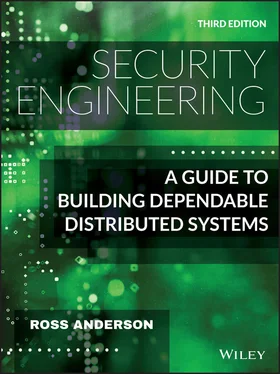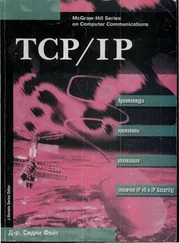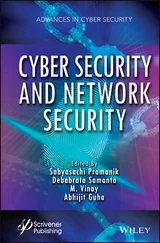Ross Anderson - Security Engineering
Здесь есть возможность читать онлайн «Ross Anderson - Security Engineering» — ознакомительный отрывок электронной книги совершенно бесплатно, а после прочтения отрывка купить полную версию. В некоторых случаях можно слушать аудио, скачать через торрент в формате fb2 и присутствует краткое содержание. Жанр: unrecognised, на английском языке. Описание произведения, (предисловие) а так же отзывы посетителей доступны на портале библиотеки ЛибКат.
- Название:Security Engineering
- Автор:
- Жанр:
- Год:неизвестен
- ISBN:нет данных
- Рейтинг книги:3 / 5. Голосов: 1
-
Избранное:Добавить в избранное
- Отзывы:
-
Ваша оценка:
Security Engineering: краткое содержание, описание и аннотация
Предлагаем к чтению аннотацию, описание, краткое содержание или предисловие (зависит от того, что написал сам автор книги «Security Engineering»). Если вы не нашли необходимую информацию о книге — напишите в комментариях, мы постараемся отыскать её.
secure? Understand how to engineer dependable systems with this newly updated classic
In
Cambridge University professor Ross Anderson updates his classic textbook and teaches readers how to design, implement, and test systems to withstand both error and attack.
This book became a best-seller in 2001 and helped establish the discipline of security engineering. By the second edition in 2008, underground dark markets had let the bad guys specialize and scale up; attacks were increasingly on users rather than on technology. The book repeated its success by showing how security engineers can focus on usability.
Now the third edition brings it up to date for 2020. As people now go online from phones more than laptops, most servers are in the cloud, online advertising drives the Internet and social networks have taken over much human interaction, many patterns of crime and abuse are the same, but the methods have evolved. Ross Anderson explores what security engineering means in 2020, including:
How the basic elements of cryptography, protocols, and access control translate to the new world of phones, cloud services, social media and the Internet of Things Who the attackers are – from nation states and business competitors through criminal gangs to stalkers and playground bullies What they do – from phishing and carding through SIM swapping and software exploits to DDoS and fake news Security psychology, from privacy through ease-of-use to deception The economics of security and dependability – why companies build vulnerable systems and governments look the other way How dozens of industries went online – well or badly <l

 . The point is that if an attacker compromises one of their systems and steals the key, he only gets the current key and is unable to decrypt back traffic. The chain of compromise is broken by the hash function's one-wayness. This property is also known as backward security . A variant is autokeying where the principals update a key by hashing it with the messages they have exchanged since the last key change:
. The point is that if an attacker compromises one of their systems and steals the key, he only gets the current key and is unable to decrypt back traffic. The chain of compromise is broken by the hash function's one-wayness. This property is also known as backward security . A variant is autokeying where the principals update a key by hashing it with the messages they have exchanged since the last key change:  . If an attacker now compromises one of their systems and steals the key, then as soon as they exchange a message which he can't observe or guess, security will be recovered; again, the chain of compromise is broken. This property is known as forward security . It was first used in banking in EFT payment terminals in Australia [208, 210]. The use of asymmetric cryptography allows a slightly stronger form of forward security, namely that as soon as a compromised terminal exchanges a message with an uncompromised one which the opponent doesn't control, security can be recovered even if the message is in plain sight. I'll describe how this works next.
. If an attacker now compromises one of their systems and steals the key, then as soon as they exchange a message which he can't observe or guess, security will be recovered; again, the chain of compromise is broken. This property is known as forward security . It was first used in banking in EFT payment terminals in Australia [208, 210]. The use of asymmetric cryptography allows a slightly stronger form of forward security, namely that as soon as a compromised terminal exchanges a message with an uncompromised one which the opponent doesn't control, security can be recovered even if the message is in plain sight. I'll describe how this works next. not dividing
not dividing  ,
,  (mod
(mod  ) (proof: take the set {1, 2, …,
) (proof: take the set {1, 2, …,  } and multiply each of them modulo
} and multiply each of them modulo  by
by  , then cancel out
, then cancel out  each side). For a general integer
each side). For a general integer  ,
,  (mod
(mod  ) where Euler's function
) where Euler's function  is the number of positive integers less than
is the number of positive integers less than  with which it has no divisor in common (the proof is similar). So if
with which it has no divisor in common (the proof is similar). So if  is the product of two primes
is the product of two primes  then
then  .
. which is hard to factor (take
which is hard to factor (take  for two large randomly chosen primes
for two large randomly chosen primes  and
and  , say of 1024 bits each) plus a public exponent
, say of 1024 bits each) plus a public exponent  that has no common factors with either
that has no common factors with either  or
or  . The private key is the factors
. The private key is the factors  and
and  , which are kept secret. Where
, which are kept secret. Where  is the message and
is the message and  is the ciphertext, encryption is defined by
is the ciphertext, encryption is defined by









